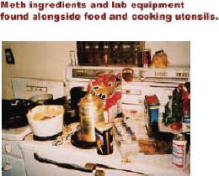Growing Up with Meth: Dangerous Living Conditions
The living environment that many Meth-exposed children face can hardly be called "home".
Explosives and booby traps (including trip wires, hidden sticks with nails or spikes, and light switches or electrical appliances wired to explosive devices) have been found at some sites.
Loaded guns and other weapons are usually present and often found in easy-to-reach locations.
Meth homes also often lack heating, cooling, legally provided electricity, running water, or refrigeration. Living and play areas may be infested with rodents and insects, including cockroaches, fleas, ticks, and lice. Individuals responding to some lab sites have found hazardous waste products and rotten food on the ground, used needles and condoms strewn about, and dirty clothes, dishes, and garbage piled on floors and countertops.
Toilets and bathtubs may be backed up or unusable, sometimes because the cook has dumped corrosive byproducts into the plumbing.
The inability of Meth addicted and manufacturing parents to function as competent caregivers increases the likelihood that a child will be accidentally injured or will ingest drugs and poisonous
substances. Baby bottles may be stored among toxic chemicals.
Hazardous Meth components may be stored in 2-liter soft drink bottles, fruit juice bottles, 2-liter soft drink bottles, fruit juice bottles, and pitchers in food preparation areas or the
refrigerator. Ashtrays and drug paraphernalia (such as razor blades, syringes, and pipes) are often found scattered within a child’s reach, sometimes even in cribs. Infants are found with Meth powder
on their clothes, bare feet, and toys. The health hazards in Meth homes from unhygienic conditions, needle sharing, and unprotected sexual activity may include hepatitis A and C, E. coli, syphilis,
and HIV.



